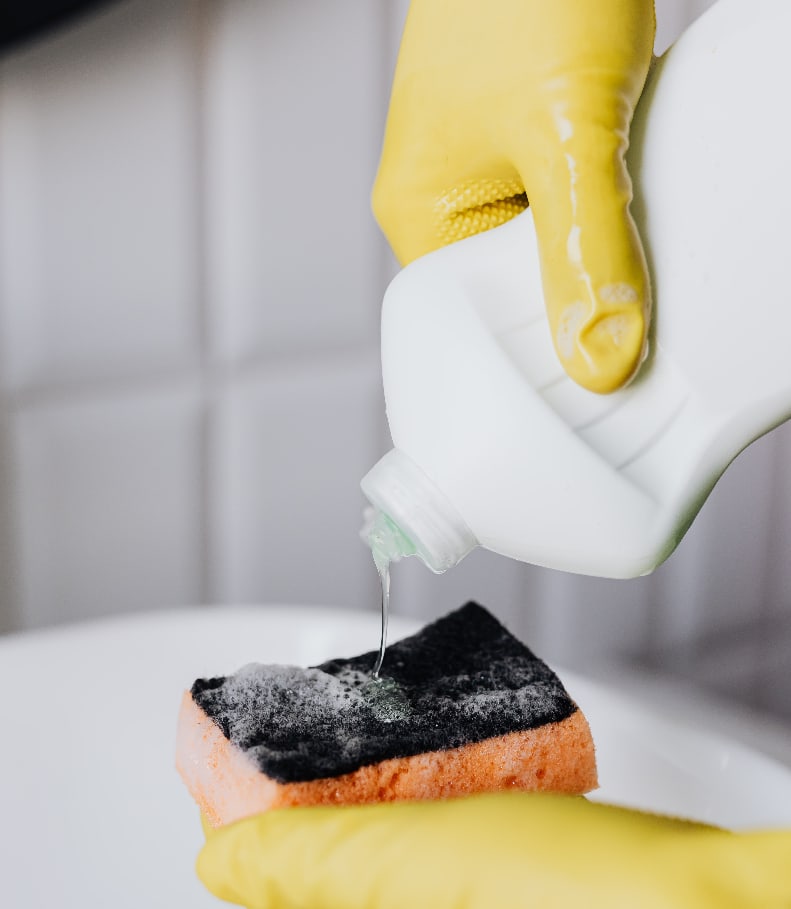If you don’t keep your kitten or cat’s litter box clean, it is likely that they’ll simply stop using it. Cats are extremely clean animals and will refuse to even step into a litter box if it is dirty. If it is full, messy or carries a strong smell then your cat will probably go elsewhere.
Cleaning the Litter Box
1. Get Out Your Gloves and Mask

Feline feces and urine can be harmful to the person cleaning the litter box so it’s best to wear litter gloves and a mask while cleaning. This may seem overkill, but it’s essential when considering the amount of parasitic organism which can be in feces.
2. Select a Good Scoop

Using a poorly designed scoop will make cleaning your cat’s litter box a pain. Selecting a good scoop is just as important as picking the right type of litter and litter box. You want a scoop which matches your litter. Large-particle litter is easiest to clean with a sieve or strainer with larger holes, while a narrow sieve is best for small-particle litter, preventing clumps of urine from falling back into the tray.
3. Choose a Detergent Type
It is best to clean a cat litter box with a mild detergent such as dish soap which doesn’t carry any strong, residual chemical odor or residue.
Try Dawn Powerwash, it’s really the best detergent we’ve ever used!
If you do use something such as bleach, you’ll have to be sure to wash the litter box thoroughly, perhaps a few times, in order to get rid of all traces of the smell. Unscented bleach and unscented detergents cost slightly more but are great for cleaning litter boxes.

Litter Genie Ultimate Cat Litter Disposal System on Amazon: Odor control, perfect for multi-cat homes.
Own More Than One Cat?
If you are the owner of more than one cat and are still struggling with toilet training on the odd occasion when it is likely that you have too few litter boxes.
Cats generally only defecate and urinate in a single place where only their own odor is present. As soon as the litter box has too many conflicting smells, one of your cats will most likely go somewhere else.
Urine is a marker of territory and even though multiple cats may share one roof, a litter box will eventually be claimed. On most occasions, more than one cat will share the litter box but at times your feline may deviate.
Cleaning Clumping Litter
Cleaning clumping litter is much easier than cleaning any other type of litter box. Most clumps of urine and feces can be scooped out using the right sized slotted scoop.
The trick to keeping clumping litter clean is to clean regularly. Given the way that defecation sticks to the litter, it is near-effortless to scoop them out a few times a day. Inspect the tray for any areas of dried out litter.
Pay extra attention to the sides and bottom of the box. Whenever you clean clumping litter make sure that the litter tray has enough cat litter in it.
Without at least 3-inches of litter, you’ll find that cleaning out clumps leaves too little behind. If your cat can’t scratch in their litter box properly, they’ll simply go somewhere else, and that place is normally inside not out.
Cleaning Non-Clumping Litter
Non-clumping litter doesn’t need to be cleaned as often as it doesn’t absorb your feline’s feces and urine into manageable, removable clumps.
Instead, you’ll find yourself throwing out the entire tray of litter once it has been used enough, typically taking just less than a week depending on what brand you use.
Litter Box Liners
If you own one or two cats only and thus keep a handful or litter boxes in your house only, then consider using litter box liners.
They are extremely convenient when using scooping litter but should be avoided by those using non-scooping as the excess urine will pool up. This being said, litter box liners are great but they need to be replaced very often.
Keeping Your Cat Litter Fresh
Avoid scented cat litters as most cats dislike any strong smell which offsets their own odor. Whenever you clean out your litter box, sprinkle some baking soda into the cat litter and mix it around.
This serves as an excellent deodorizer which is completely safe for kitty and much cheaper than a commercial litter box deodorizing agent.
Activated Charcoal to Effectively Eliminate Odors
Another great way to minimize odor is by placing activated charcoal briquettes or filters on the bottom of the cat litter box before covering them with litter.
Even a small amount of activated charcoal placed near the box will do wonders for any lingering smells.
Protect the Surrounding Area
Certain cats don’t like leaving the litter in the litter box, preferring to dig fervently, potentially scattering litter everywhere surrounding it.
Once you’re done cleaning the tray, be sure to line the surrounding area with a mat which you purpose for your pet and wash regularly, or a large piece of plastic, newspapers or any other covering you prefer.
What to Do When Your Cat Breaks Bathroom Habits
There are many possible reasons for a cat breaking its regular habits. If you find your cat peeing or leaving behind feces in a random place inside your house then you can normally attribute this to:
- An overly full litter box
- A litter box carrying a foreign, overpowering scent
- A litter box which has undergone a significant odor change from its normal smell
- Extreme stress upon the cat’s lifestyle (factors interfering with habits of your cat e.g. change of home, the addition of a new pet, a litter box location change)
- A perceived threat in the area of the litter box (e.g. dogs in the household capable of accessing the tray, an overcrowded or high-traffic area of the house)
During litter box training or any other time that your cat suddenly stops using the litter box, you should never punish them.
Yelling, violence or any expression of anger is going to do nothing other than place stress on your feline friend, in turn raising the chances that they’ll relieve themselves somewhere random again instead of remembering and reverting to their litter box habit.
Maintain a Regular Cleaning Schedule
The best way to make sure that your cat is at no potential health risk while minimizing the smell, effort and time that it takes to clean a litter box, clean regularly. You won’t need to empty out all the litter every time.
Scooping twice a day at a minimum will keep your litter fresh for longer while keeping the tray clean enough for kitty to always use it. Three times is even better.
Light cleaning takes under a minute or two while having to empty out all the litter followed by scraping and scrubbing crusty feces and gunky pee from the box itself is no task which anyone enjoys; it also takes forever.
Rather scoop daily and clean thoroughly once a week. It’ll give you more use out of your litter and your box, and it’s the best all-around option for your cat and hygiene.
To add to your cat furniture, take a look at the PetFusion Jumbo Cat Scratcher Lounge. Cats want to make their living space their own to be happy. Providing them with essential pieces of cat furniture is key giving them their space to allow them to be happy.
How much litter to put in litter box
Most cat litter manufacturers recommend using 2 to 3 inches of litter. This will give your cat enough litter for digging and adequate covering afterward.
You also need to pay attention to your cat habits to know exactly how much litter to put. 🙂



